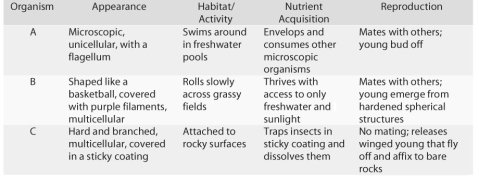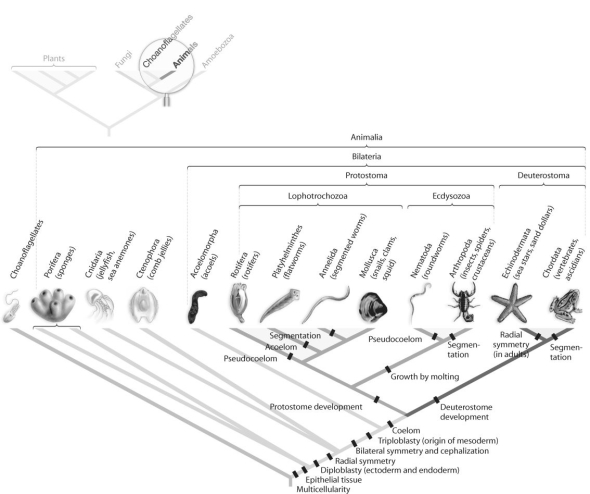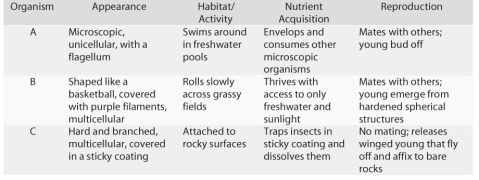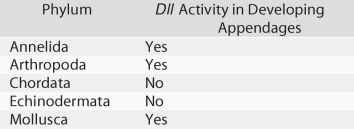Deck 32: An Introduction to Animals
Question
Question
Question
Question
Question
Question
Question
Question
Question
Question
Question
Question
Question
Question
Question
Question
Question
Question
Question
Question
Question
Question
Question
Question
Question
Question
Question
Question
Question
Question
Question
Question
Question
Question
Question
Question
Question
Question

Unlock Deck
Sign up to unlock the cards in this deck!
Unlock Deck
Unlock Deck
1/38
Play
Full screen (f)
Deck 32: An Introduction to Animals
1
Figure 32.1

From the information provided in the figure above,how would you classify the feeding strategy of organism C?
A)suspension feeding
B)predation
C)parasitism
D)suspension feeding and predation
E)predation and parasitism

From the information provided in the figure above,how would you classify the feeding strategy of organism C?
A)suspension feeding
B)predation
C)parasitism
D)suspension feeding and predation
E)predation and parasitism
D
2
If you think of the tube-within-a-tube body plan as a pipe with a straw inside,where would you expect to find most of the ectodermal,mesodermal,and endodermal germ layers,respectively?
A)pipe;space between pipe and straw;straw
B)straw;space between pipe and straw;pipe
C)space inside of straw;straw;space between pipe and straw
D)pipe;straw;space inside of straw
A)pipe;space between pipe and straw;straw
B)straw;space between pipe and straw;pipe
C)space inside of straw;straw;space between pipe and straw
D)pipe;straw;space inside of straw
A
3
While looking at some seawater through your microscope,you spot the egg of an unknown animal.Which of the following tests could you not use to determine whether the developing organism is a protostome or a deuterostome?
A)See whether the ectoderm forms the mature animal's skin/exoskeleton or nervous system.
B)See whether the animal exhibits spiral cleavage or radial cleavage during early development.
C)See whether the coelom is formed from a split in the mesoderm or from mesodermal pockets pinched off the gut.
D)See whether the pore formed during gastrulation becomes the mature animal's mouth or its anus.
A)See whether the ectoderm forms the mature animal's skin/exoskeleton or nervous system.
B)See whether the animal exhibits spiral cleavage or radial cleavage during early development.
C)See whether the coelom is formed from a split in the mesoderm or from mesodermal pockets pinched off the gut.
D)See whether the pore formed during gastrulation becomes the mature animal's mouth or its anus.
A
4
Figure 32.2

Which morphological trait evolved more than once in animals,according to the phylogeny based on DNA sequence data found in Figure 32.2 above?
A)coelom
B)bilateral symmetry
C)segmentation
D)tissue
E)protostome development

Which morphological trait evolved more than once in animals,according to the phylogeny based on DNA sequence data found in Figure 32.2 above?
A)coelom
B)bilateral symmetry
C)segmentation
D)tissue
E)protostome development

Unlock Deck
Unlock for access to all 38 flashcards in this deck.
Unlock Deck
k this deck
5
Figure 32.1

As you are on the way to Tahiti for a vacation,your plane crash-lands on a previously undiscovered island.You soon find that the island is teeming with unfamiliar organisms;and you,as a student of biology,decide to survey them (with the aid of the Insta-Lab Portable Laboratory you brought along in your suitcase).You select three organisms and observe them in detail,making the notations found in Figure 32.1.Which organism would you classify as an animal?
A)organism A
B)organism B
C)organism C

As you are on the way to Tahiti for a vacation,your plane crash-lands on a previously undiscovered island.You soon find that the island is teeming with unfamiliar organisms;and you,as a student of biology,decide to survey them (with the aid of the Insta-Lab Portable Laboratory you brought along in your suitcase).You select three organisms and observe them in detail,making the notations found in Figure 32.1.Which organism would you classify as an animal?
A)organism A
B)organism B
C)organism C

Unlock Deck
Unlock for access to all 38 flashcards in this deck.
Unlock Deck
k this deck
6
Which tissue type,or organ,is not correctly matched with its germ layer tissue?
A)nervous-mesoderm
B)muscular-mesoderm
C)stomach-endoderm
D)skin-ectoderm
E)skeletal-mesoderm
A)nervous-mesoderm
B)muscular-mesoderm
C)stomach-endoderm
D)skin-ectoderm
E)skeletal-mesoderm

Unlock Deck
Unlock for access to all 38 flashcards in this deck.
Unlock Deck
k this deck
7
Figure 32.3
Use Figure 32.3 and the following information when answering the next question.
In a review paper published in 2000,Adoutte et al.examined some animal phylogenies generated by comparing the ribosomal RNA (rRNA)of animals from many different phyla.They then integrated these independently created phylogenies into one phylogeny that best fit all the data.
Figure 32.3 compares a traditional phylogeny based on morphological characteristics (A)to the new molecular-based phylogeny described by Adoutte et al.(B).
Note that platyhelminthes,nemerteans,and entoprocts,which do not have coeloms and are classified as acoelomates in the morphological phylogeny,are reclassified as lophotrochozoans in the molecular phylogeny.Similarly,groups classified as pseudocoelomates in the morphological phylogeny are reclassified as either lophotrochozoans or ecdysozoans in the molecular phylogeny;other lophotrochozoans and ecdysozoans have coeloms.

Refer to the paragraph on Adoutte et al.and Figure 32.3.What does this reclassification based on molecular data imply about the evolution of acoelomates,pseudocoelomates,and coelomates?
A)Pseudocoelomates can be seen as an intermediate stage between acoelomate and coelomate development.
B)Although acoelomates and pseudocoelomates evolved only once,coelomates evolved multiple times in different lineages.
C)Only the animals that evolved earliest are acoelomates.
D)Some pseudocoelomates and acoelomates have evolved from coelomates.
Use Figure 32.3 and the following information when answering the next question.
In a review paper published in 2000,Adoutte et al.examined some animal phylogenies generated by comparing the ribosomal RNA (rRNA)of animals from many different phyla.They then integrated these independently created phylogenies into one phylogeny that best fit all the data.
Figure 32.3 compares a traditional phylogeny based on morphological characteristics (A)to the new molecular-based phylogeny described by Adoutte et al.(B).
Note that platyhelminthes,nemerteans,and entoprocts,which do not have coeloms and are classified as acoelomates in the morphological phylogeny,are reclassified as lophotrochozoans in the molecular phylogeny.Similarly,groups classified as pseudocoelomates in the morphological phylogeny are reclassified as either lophotrochozoans or ecdysozoans in the molecular phylogeny;other lophotrochozoans and ecdysozoans have coeloms.

Refer to the paragraph on Adoutte et al.and Figure 32.3.What does this reclassification based on molecular data imply about the evolution of acoelomates,pseudocoelomates,and coelomates?
A)Pseudocoelomates can be seen as an intermediate stage between acoelomate and coelomate development.
B)Although acoelomates and pseudocoelomates evolved only once,coelomates evolved multiple times in different lineages.
C)Only the animals that evolved earliest are acoelomates.
D)Some pseudocoelomates and acoelomates have evolved from coelomates.

Unlock Deck
Unlock for access to all 38 flashcards in this deck.
Unlock Deck
k this deck
8
Which of the following is true of the sponges?
A)Their larvae are motile,and move via the motion of cilia.
B)They are the simplest diploblastic animals.
C)They exhibit bilateral symmetry.
D)They have a nerve net but not a CNS.
E)Their feeding cells are called choanoflagellates.
A)Their larvae are motile,and move via the motion of cilia.
B)They are the simplest diploblastic animals.
C)They exhibit bilateral symmetry.
D)They have a nerve net but not a CNS.
E)Their feeding cells are called choanoflagellates.

Unlock Deck
Unlock for access to all 38 flashcards in this deck.
Unlock Deck
k this deck
9
Which of the following species would you not classify as an animal?
A)sponges
B)coral
C)jellyfish
D)choanoflagellates
A)sponges
B)coral
C)jellyfish
D)choanoflagellates

Unlock Deck
Unlock for access to all 38 flashcards in this deck.
Unlock Deck
k this deck
10
An organism that exhibits cephalization probably also _____.
A)is bilaterally symmetrical
B)has a hydrostatic skeleton
C)has a coelom
D)is segmented
E)is diploblastic
A)is bilaterally symmetrical
B)has a hydrostatic skeleton
C)has a coelom
D)is segmented
E)is diploblastic

Unlock Deck
Unlock for access to all 38 flashcards in this deck.
Unlock Deck
k this deck
11
In examining an unknown animal species during its embryonic development,how can you be sure what you are looking at is a protostome and not a deuterostome?
A)There is evidence of cephalization.
B)You see a well-developed coelom.
C)The animal is triploblastic.
D)The animal is clearly bilaterally symmetrical.
E)You see a mouth,but not an anus.
A)There is evidence of cephalization.
B)You see a well-developed coelom.
C)The animal is triploblastic.
D)The animal is clearly bilaterally symmetrical.
E)You see a mouth,but not an anus.

Unlock Deck
Unlock for access to all 38 flashcards in this deck.
Unlock Deck
k this deck
12
Why might researchers choose to use molecular data (such as ribosomal RNA sequences)rather than morphological data to study the evolutionary history of animals?
A)Molecular data can be gathered in the lab,while morphological data must be gathered in the field.
B)Sequence data can be gathered faster than morphological data,and morphological data can lead to wrong conclusions.
C)Morphological changes usually don't result from molecular changes.
D)Some phyla vary too widely in morphological characteristics to be classified accurately.
A)Molecular data can be gathered in the lab,while morphological data must be gathered in the field.
B)Sequence data can be gathered faster than morphological data,and morphological data can lead to wrong conclusions.
C)Morphological changes usually don't result from molecular changes.
D)Some phyla vary too widely in morphological characteristics to be classified accurately.

Unlock Deck
Unlock for access to all 38 flashcards in this deck.
Unlock Deck
k this deck
13
Which of the following is a feature of the tube-within-a-tube body plan in most animals?
A)The outer tube consists of a hard exoskeleton.
B)The outer tube consists of digestive organs.
C)The mouth and anus form the ends of the inner tube.
D)The two "tubes" are separated by endoderm tissue.
A)The outer tube consists of a hard exoskeleton.
B)The outer tube consists of digestive organs.
C)The mouth and anus form the ends of the inner tube.
D)The two "tubes" are separated by endoderm tissue.

Unlock Deck
Unlock for access to all 38 flashcards in this deck.
Unlock Deck
k this deck
14
What do biologists cite as the primary benefit of the evolution of a coelom in animals?
A)the hydrostatic skeleton,allowing greater range of motion
B)a more efficient digestive system,in the form of a tube-within-a-tube
C)cephalization and the formation of a cerebral ganglion
D)the subsequent evolution of segmentation
A)the hydrostatic skeleton,allowing greater range of motion
B)a more efficient digestive system,in the form of a tube-within-a-tube
C)cephalization and the formation of a cerebral ganglion
D)the subsequent evolution of segmentation

Unlock Deck
Unlock for access to all 38 flashcards in this deck.
Unlock Deck
k this deck
15
Suppose a researcher for a pest-control company developed a chemical that inhibited the development of an embryonic mosquito's endodermal cells.Which of the following would be a likely mechanism by which this pesticide works?
A)The mosquito would develop a weakened exoskeleton that would make it vulnerable to trauma.
B)The mosquito would have trouble digesting food,due to impaired gut function.
C)The mosquito would have trouble with respiration and circulation,due to impaired muscle function.
D)The mosquito wouldn't be affected at all.
A)The mosquito would develop a weakened exoskeleton that would make it vulnerable to trauma.
B)The mosquito would have trouble digesting food,due to impaired gut function.
C)The mosquito would have trouble with respiration and circulation,due to impaired muscle function.
D)The mosquito wouldn't be affected at all.

Unlock Deck
Unlock for access to all 38 flashcards in this deck.
Unlock Deck
k this deck
16
The evolution of animal species has been prolific (the estimates go into the millions and tens of millions).To what does the text attribute much of this diversity?
A)novel reproductive strategies
B)a large variety of body plans
C)a large variety of methods for capturing and processing food
D)a complex nervous system providing the intelligence for survival in difficult times
E)the development of multiple tissue types
A)novel reproductive strategies
B)a large variety of body plans
C)a large variety of methods for capturing and processing food
D)a complex nervous system providing the intelligence for survival in difficult times
E)the development of multiple tissue types

Unlock Deck
Unlock for access to all 38 flashcards in this deck.
Unlock Deck
k this deck
17
You find a new species of worm and want to classify it.Which of the following lines of evidence would allow you to classify the worm as a nematode and not an annelid?
A)It undergoes protostome development.
B)It is segmented.
C)It is triploblastic.
D)It has a coelom.
E)It sheds its external skeleton to grow.
A)It undergoes protostome development.
B)It is segmented.
C)It is triploblastic.
D)It has a coelom.
E)It sheds its external skeleton to grow.

Unlock Deck
Unlock for access to all 38 flashcards in this deck.
Unlock Deck
k this deck
18
The digestive system of most animals is lined with cells through which nutrients are absorbed.What is the embryonic origin of these cells?
A)endoderm
B)ectoderm
C)mesoderm
A)endoderm
B)ectoderm
C)mesoderm

Unlock Deck
Unlock for access to all 38 flashcards in this deck.
Unlock Deck
k this deck
19
Which of the following is most likely to be aquatic?
A)suspension feeder
B)mass feeder
C)deposit feeder
D)fluid feeder
A)suspension feeder
B)mass feeder
C)deposit feeder
D)fluid feeder

Unlock Deck
Unlock for access to all 38 flashcards in this deck.
Unlock Deck
k this deck
20
The eye of most vertebrates has a flexible lens which changes shape,by the action of the ciliary muscle,depending on the distance between the lens and the object on which the animal is focusing.Which mollusk's eye is most similar to the vertebrate eye?
A)limpets
B)abalones
C)squids
D)snails
E)scallops
A)limpets
B)abalones
C)squids
D)snails
E)scallops

Unlock Deck
Unlock for access to all 38 flashcards in this deck.
Unlock Deck
k this deck
21
What do all sponges have in common?
A)They all have three germ layers.
B)All adults are free swimming.
C)They always reproduce sexually.
D)They all practice external fertilization.
E)They all live on the bottom in an aquatic environment.
A)They all have three germ layers.
B)All adults are free swimming.
C)They always reproduce sexually.
D)They all practice external fertilization.
E)They all live on the bottom in an aquatic environment.

Unlock Deck
Unlock for access to all 38 flashcards in this deck.
Unlock Deck
k this deck
22
Due to its unusual habitat (inside the digestive tracts of other animals),the tapeworm lacks _____.
A)a head
B)a mouth
C)a digestive tract
D)a mouth and a digestive tract
E)a head,a mouth,and a digestive tract
A)a head
B)a mouth
C)a digestive tract
D)a mouth and a digestive tract
E)a head,a mouth,and a digestive tract

Unlock Deck
Unlock for access to all 38 flashcards in this deck.
Unlock Deck
k this deck
23
What would you expect to happen if,in the experiment outlined in Figure 32.19,researchers supplied an enzyme that blocked the expression of the Dll gene?
A)The embryo would have appendages in abnormal locations.
B)The origins of the embryo's appendages would fluoresce.
C)The developing embryo would have no appendages.
D)The embryo's appendages would be shorter than usual.
A)The embryo would have appendages in abnormal locations.
B)The origins of the embryo's appendages would fluoresce.
C)The developing embryo would have no appendages.
D)The embryo's appendages would be shorter than usual.

Unlock Deck
Unlock for access to all 38 flashcards in this deck.
Unlock Deck
k this deck
24
Comb jellies may not be the most familiar animal to you,but they are critical in the food chain because they make up a significant portion of the planktonic biomass.Their feeding strategy is predatory and involves adhesives or mucus on their tentacles or other body parts.What feeding tactic do these animals use?
A)suspension feeder
B)fluid feeder
C)deposit feeder
D)food-mass feeder
A)suspension feeder
B)fluid feeder
C)deposit feeder
D)food-mass feeder

Unlock Deck
Unlock for access to all 38 flashcards in this deck.
Unlock Deck
k this deck
25
All of the following are true about choanoflagellates except _____.
A)they are suspension feeders
B)they are sessile as adults
C)they live in aquatic habitats
D)they are animals
E)they reproduce asexually
A)they are suspension feeders
B)they are sessile as adults
C)they live in aquatic habitats
D)they are animals
E)they reproduce asexually

Unlock Deck
Unlock for access to all 38 flashcards in this deck.
Unlock Deck
k this deck
26
Most cnidarians are known to produce toxins.In fact,it has been claimed that one particular species produces the most deadly of all toxins on the planet.What feature of this group most likely evolved simultaneously with the development of these toxins?
A)the medusa body form
B)asexual reproduction
C)a slow-moving or sessile lifestyle in the adult
D)diploblastic design
E)bilateral symmetry in the mobile larval forms
A)the medusa body form
B)asexual reproduction
C)a slow-moving or sessile lifestyle in the adult
D)diploblastic design
E)bilateral symmetry in the mobile larval forms

Unlock Deck
Unlock for access to all 38 flashcards in this deck.
Unlock Deck
k this deck
27
Why are healthy corals brightly colored?
A)Corals secrete colorful pigments to warn predators that they are poisonous.
B)Corals secrete colorful pigments to attract mates.
C)Corals host symbionts with colorful photosynthetic pigments.
D)Corals build their skeletons from colorful minerals.
E)Corals secrete colorful pigments to protect themselves from UV light.
A)Corals secrete colorful pigments to warn predators that they are poisonous.
B)Corals secrete colorful pigments to attract mates.
C)Corals host symbionts with colorful photosynthetic pigments.
D)Corals build their skeletons from colorful minerals.
E)Corals secrete colorful pigments to protect themselves from UV light.

Unlock Deck
Unlock for access to all 38 flashcards in this deck.
Unlock Deck
k this deck
28
Which of the following would most strongly support your hypothesis that an animal you are observing is an ectoparasite?
A)wormlike body
B)a scolex
C)hooks on its head region
D)lack of a digestive system
E)limbs with claws
A)wormlike body
B)a scolex
C)hooks on its head region
D)lack of a digestive system
E)limbs with claws

Unlock Deck
Unlock for access to all 38 flashcards in this deck.
Unlock Deck
k this deck
29
To reproduce,many plants produce seeds-structures containing embryonic offspring along with nutrients inside a tough case.These offspring develop after being released by the parent plant.To which animal reproductive strategy is seed production most comparable?
A)oviparous reproduction
B)ovoviviparous reproduction
C)viviparous reproduction
A)oviparous reproduction
B)ovoviviparous reproduction
C)viviparous reproduction

Unlock Deck
Unlock for access to all 38 flashcards in this deck.
Unlock Deck
k this deck
30
Which of the following feeding tactics is consistent with this list of features:
Two-part stomach capable of breaking down tough food particles;simple mouthparts;the ability to burrow through,and consume,indigestible fecal material to get to hidden food?
A)suspension feeder
B)fluid feeder
C)deposit feeder
D)food-mass feeder
Two-part stomach capable of breaking down tough food particles;simple mouthparts;the ability to burrow through,and consume,indigestible fecal material to get to hidden food?
A)suspension feeder
B)fluid feeder
C)deposit feeder
D)food-mass feeder

Unlock Deck
Unlock for access to all 38 flashcards in this deck.
Unlock Deck
k this deck
31
Most fish deposit fertilized eggs,but some sharks keep the fertilized egg inside the female until she gives birth to a relatively well-developed pup.These sharks would thus be characterized as _____.
A)live-bearing
B)ovoviviparous
C)oviparous
D)viviparous
A)live-bearing
B)ovoviviparous
C)oviparous
D)viviparous

Unlock Deck
Unlock for access to all 38 flashcards in this deck.
Unlock Deck
k this deck
32
If humans were characterized as undergoing metamorphosis,human development from infant to adult would be better described as _____,and human infants would be described as _____.
A)hemimetabolous metamorphosis;nymphs
B)holometabolous metamorphosis;nymphs
C)hemimetabolous metamorphosis;larvae
D)holometabolous metamorphosis;larvae
A)hemimetabolous metamorphosis;nymphs
B)holometabolous metamorphosis;nymphs
C)hemimetabolous metamorphosis;larvae
D)holometabolous metamorphosis;larvae

Unlock Deck
Unlock for access to all 38 flashcards in this deck.
Unlock Deck
k this deck
33
Which of the following groups of terms best describes the acoelomorpha?
A)diploblastic;bilaterally symmetric;complex digestive tracts;mobile
B)triploblastic;radially symmetric;simple digestive tracts;mobile
C)triploblastic;bilaterally symmetric;simple digestive tracts;mobile
D)triploblastic;radially symmetric;simple digestive tracts;immobile
A)diploblastic;bilaterally symmetric;complex digestive tracts;mobile
B)triploblastic;radially symmetric;simple digestive tracts;mobile
C)triploblastic;bilaterally symmetric;simple digestive tracts;mobile
D)triploblastic;radially symmetric;simple digestive tracts;immobile

Unlock Deck
Unlock for access to all 38 flashcards in this deck.
Unlock Deck
k this deck
34
A radula is a specialized feeding organ,used to scrape material off of food for ingestion,much like a cheese grater scrapes shreds off of a block of cheese.Snails,which have this structure,are thus which kind of feeder?
A)suspension feeder
B)fluid feeder
C)deposit feeder
D)mass feeder
A)suspension feeder
B)fluid feeder
C)deposit feeder
D)mass feeder

Unlock Deck
Unlock for access to all 38 flashcards in this deck.
Unlock Deck
k this deck
35
Parasitism is one of the most widespread life strategies ever to evolve.Which of the following is consistent with this finding?
A)Parasites almost always predigest their hosts' tissues and therefore spend less energy and require fewer structural adaptations.
B)Parasites,unlike predators,feed on almost all the tissues of their host.
C)Parasites do not generally kill their hosts,thus they can feed on the same host throughout the host's normal life span and do not have competition from decomposers.
D)Parasites generally kill their host and can feed for a very long time because they are much smaller than their host.
A)Parasites almost always predigest their hosts' tissues and therefore spend less energy and require fewer structural adaptations.
B)Parasites,unlike predators,feed on almost all the tissues of their host.
C)Parasites do not generally kill their hosts,thus they can feed on the same host throughout the host's normal life span and do not have competition from decomposers.
D)Parasites generally kill their host and can feed for a very long time because they are much smaller than their host.

Unlock Deck
Unlock for access to all 38 flashcards in this deck.
Unlock Deck
k this deck
36
Suppose you came across a novel organism you suspected belonged to one of the following animal phyla:
Porifera,Cnidaria,Ctenophora,or Acoelomorpha.Which of the following characteristics would not be helpful in placing the organism into the correct phylum?
A)the organism's feeding strategy
B)the organism's habitat
C)whether the organism has a coelom
D)whether the organism has a gut
E)whether adults are sessile or motile
Porifera,Cnidaria,Ctenophora,or Acoelomorpha.Which of the following characteristics would not be helpful in placing the organism into the correct phylum?
A)the organism's feeding strategy
B)the organism's habitat
C)whether the organism has a coelom
D)whether the organism has a gut
E)whether adults are sessile or motile

Unlock Deck
Unlock for access to all 38 flashcards in this deck.
Unlock Deck
k this deck
37
Following the fusion of gametes in Obelia,the resulting cell divides via mitosis to become a _____.
A)larva
B)polyp
C)nymph
D)medusa
A)larva
B)polyp
C)nymph
D)medusa

Unlock Deck
Unlock for access to all 38 flashcards in this deck.
Unlock Deck
k this deck
38
Figure 32.4

Dll is a gene known to direct limb development in the fruit fly.Researchers studying this gene have found that it is also expressed in developing appendages in animals from many other phyla as well,supporting the hypothesis that all animal appendages may be homologous.However,suppose researchers looking at Dll activity had instead found the results shown in Figure 32.4.What would these results suggest?
A)Dll is not actually involved in appendage development.
B)Appendages evolved separately in protostomes and deuterostomes.
C)Appendages coevolved with segmentation.
D)All animal appendages are homologous.

Dll is a gene known to direct limb development in the fruit fly.Researchers studying this gene have found that it is also expressed in developing appendages in animals from many other phyla as well,supporting the hypothesis that all animal appendages may be homologous.However,suppose researchers looking at Dll activity had instead found the results shown in Figure 32.4.What would these results suggest?
A)Dll is not actually involved in appendage development.
B)Appendages evolved separately in protostomes and deuterostomes.
C)Appendages coevolved with segmentation.
D)All animal appendages are homologous.

Unlock Deck
Unlock for access to all 38 flashcards in this deck.
Unlock Deck
k this deck



